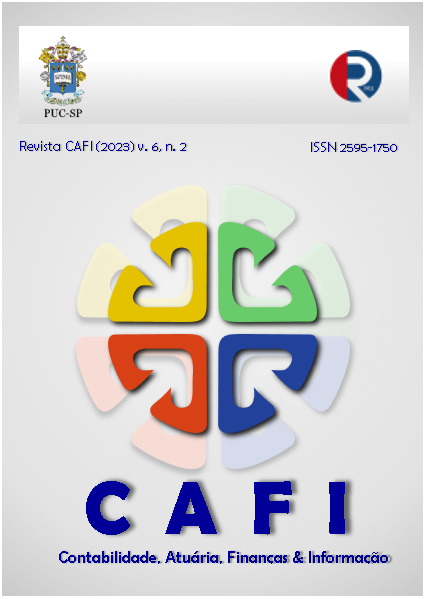Crunching Numbers, Making Decisions: Artificial Intelligence and Statistics for Financial Distress Forecasting in Algeria and Saudi Arabia
DOI:
https://doi.org/10.23925/cafi.62.60718Palabras clave:
dificultades financieras, anticipación, red neuronal artificial, regresión logísticaResumen
Predicting financial distress has been a significant concern for both researchers and practitioners for long period. This topic has garnered substantial interest due to the potential benefits of using predictive models to anticipate financial troubles and help companies steer clear of financial risks that could lead to bankruptcy and liquidation. The primary aim of this research is to forecast financial distress, comparing the effectiveness of Artificial Neural Network (ANN) with Logistic Regression (LR). This evaluation is based on data from 12 Algerian companies and 12 Saudi companies during the period from 2015 to 2019. The study's findings indicate that the LR model outperformed the Wide Neural Network (WNN) model in accurately predicting financial distress, achieving optimal classification accuracy for both Algerian and Saudi companies. Consequently, the LR model emerges as the preferred choice for forecasting financial distress in both countries.
Citas
Altman, E. (1968). Financial ratios, discriminant analysis, and the prediction of corporate bankruptcy . Journal of Finance, 23(4), 589-609.
Angel, M., Gámez, G. G., José, A., & Ruiz, C. (2016). Applying a probabilistic neural network to hotel bankruptcy prediction. Tourism & Management Studies, 12(1), 40-52.
Bayraci, S., & Susuz, O. (2019). A Deep Neural Network (DNN) based classification model in application to loan default prediction. Theoretical and Applied Economics, XXVI(4 (621)), 75-84.
Beaver, W. H. (1966). Financial ratios as predictors of failure. Journal of Accounting Research, 4, 71-111.
Bonello, J., Bredart, X., & Vella, V. (2018). Machine Learning Models For Predicting Financial Distress. Journal of Research in Economics(2), 174-185.
Callejón, A., Casado, A., Fernández, M., & Peláez, J. (2013). A System of Insolvency Prediction for industrial companies using a financial alternative model with neural networks. Int. J. Comput. Intell. Syst, 6(1), 29-37.
El-Bannany, M., Sreedharan, M., & Ahmed, M. (2020). A Robust Deep Learning Model for Financial Distress Prediction. International Journal of Advanced Computer Science and Applications, 11(2), 170-175.
Hardinata, L., & Warsito, B. S. (2018). Bankruptcy prediction based on financial ratios using Jordan Recurrent Neural Networks: a case study in Polish companies. Journal of Physics, 1025(1), 1-6.
Kapil, S., & Agarwal, S. (2019). Assessing Bankruptcy of Indian Listed Firms Using Bankruptcy Models. Decision Tree and Neural Network . International journal of business and economics, 4(1), 112-136.
Mousavi, S., Amini, M., & Raftar, M. (2012). Data mining techniques and predicting corporate financial distress. Interdisciplinary Journal of Contemporary Research in Business, 3(12), 61-68.
Ohlson, A. (1980). Financial ratios and the probabilistic prediction of bankruptcy. Journal of Accounting Research, 18(1), 109–131.
Osho, A., & Idowu, A. (2018). Relevance of Accounting Theory in Forecasting Techniques and Default Prediction in an Organization in Nigeria. European Journal of Business and Management, 10(29), 116-129.
Ribeiro, B., Silva, C., Vieira, A., & Gaspar-Cunha, A. :. (2010). Financial distress model prediction using SVM+. The 2010 International Joint Conference on Neural Networks (IJCNN), (pp. 1-7).
Sabek, A. (2023). Unveiling the diverse efficacy of artificial neural networks and logistic regression: A comparative analysis in predicting financial distress. Croatian Review of Economic, Business and Social Statistics (CREBSS), 9(1), 16-32.
Sabek, A., & Horak, J. (2023). Gaussian Process Regression´s Hyperparameters Optimization to Predict Financial Distress. Retos, Revista de Ciencias Administrativas y EconA3micas, 13(26), 273-289.
Sabek, A., & saihi, Y. (2021). Using Artificial Neural Network To Predict The Financial Distress: The Case Of Some Algerian Companies. Journal of North African Economics, 17(3), 475-492.
Sudarsanam, S. (2016). A Fuzzy Neural Network Model for Bankruptcy Prediction. Journal of Engineering Computers & Applied Sciences, 5(6), 33-40.
Tang, Y., Ji, J., Zhu, Y., Gao, S., Tang, Z., & Todo, Y. (2019). A Differential Evolution-Oriented Pruning Neural Network Model for Bankruptcy Prediction. Complexity, 2019, 1-21.
Xie, C., Luo, C., & Yu, X. (2011). Financial distress prediction based on SVM and MDA methods: the case of Chinese listed companies. Quality and Quantity: International Journal of Methodology, 45(3), 671-686.
Descargas
Publicado
Cómo citar
Número
Sección
Licencia
Derechos de autor 2023 CAFI

Esta obra está bajo una licencia internacional Creative Commons Atribución 4.0.
Declaração de Direito Autoral
Autores mantém os direitos autorais e concedem à revista o direito de primeira publicação, com o trabalho simultaneamente licenciado sob a Licença Creative Commons Attribution que permite o compartilhamento do trabalho com reconhecimento da autoria e publicação inicial nesta revista.
Declaração de Privacidade
Os nomes e endereços informados nesta revista serão usados exclusivamente para os serviços prestados por esta publicação, não sendo disponibilizados para outras finalidades ou a terceiros.









